
 |
Tea Clipper |
 |
| from TeaAntiques.com | ||
| Edition Fifty Eight |
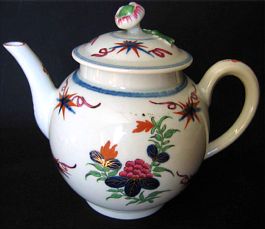 A
very attractive and rare Worcester teapot complete with its original cover and beautifully
decorated with 'polychrome' pattern known as 'Thunder & Lightning' or 'Electric'
pattern, c1770.
A
very attractive and rare Worcester teapot complete with its original cover and beautifully
decorated with 'polychrome' pattern known as 'Thunder & Lightning' or 'Electric'
pattern, c1770.
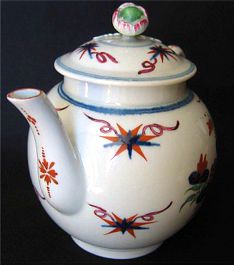
This very elegant teapot is of a 'globular' shape and of excellent proportions. It is made of soft paste porcelain and is typical of the shape popular in the eighteenth century.
The smooth body of this stunning teapot is beautifully decorated with a very pretty 'Thunder & Lightning' design on either side and includes the stylistic thunder clouds with lightning bolts around a spray of flowers and foliage in the centre of the teapot's body. These decorations are exquisitely painted by hand and of striking colours. They are based upon underglaze blue decoration that is then embellished with the other colours of oxide orange, pink, blue and green.
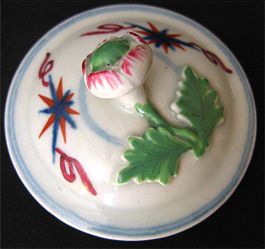 The
decoration on the low domed shaped lid of the teapot continues the same theme as
that of the teapot's body decoration, with two thunder and lightning patterns
and the double underglaze blue lines on the rim and near the centre of the cover.
The finial of the lid is of a moulded open flower, rather in the shape of a buttercup
and having a curved stem and leaves moulded onto the lid. This charming flower finial
has pink striped edged petals and green embellished stamens in the centre of the
flower. The leaves of the flower finial are painted in green also. This most charming
finial to the lid of the pot adds such elegance to the teapot and is in excellent
condition.
The
decoration on the low domed shaped lid of the teapot continues the same theme as
that of the teapot's body decoration, with two thunder and lightning patterns
and the double underglaze blue lines on the rim and near the centre of the cover.
The finial of the lid is of a moulded open flower, rather in the shape of a buttercup
and having a curved stem and leaves moulded onto the lid. This charming flower finial
has pink striped edged petals and green embellished stamens in the centre of the
flower. The leaves of the flower finial are painted in green also. This most charming
finial to the lid of the pot adds such elegance to the teapot and is in excellent
condition.
It is a fine teapot for the connoisseur collector of early Worcester wares.
More details of this item and other tea related antiques can be found by visiting my web site at www.TeaAntiques.com.
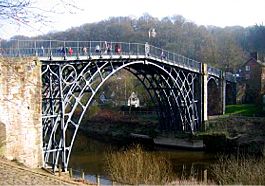 To
the North West of Birmingham is the most picturesque town of Ironbridge, situated
in the beautiful Ironbridge Gorge, through which flows the River Severn. This area
is now a World Heritage site, it being a place of outstanding industrial importance,
it was here that the industrial revolution started in England and then spread across
the world. As I was to discover, in the centre of Ironbridge stands the worlds first
cast iron bridge, hence the town's name. This graceful bridge spans the Gorge and
was built by Abraham Darby III and has on one side the accompanying toll house.
This bridge connected both sides of the deep Gorge at Ironbridge, whilst allowing
the sailing boats to sail beneath it on their trading routes towards Bristol and
from there on to the rest of the world.
To
the North West of Birmingham is the most picturesque town of Ironbridge, situated
in the beautiful Ironbridge Gorge, through which flows the River Severn. This area
is now a World Heritage site, it being a place of outstanding industrial importance,
it was here that the industrial revolution started in England and then spread across
the world. As I was to discover, in the centre of Ironbridge stands the worlds first
cast iron bridge, hence the town's name. This graceful bridge spans the Gorge and
was built by Abraham Darby III and has on one side the accompanying toll house.
This bridge connected both sides of the deep Gorge at Ironbridge, whilst allowing
the sailing boats to sail beneath it on their trading routes towards Bristol and
from there on to the rest of the world.
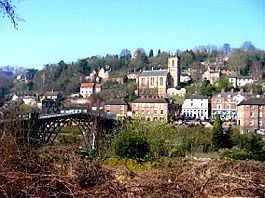 Crossing
the bridge today, where only foot passage is allowed and with the attractive town
built up on the hill, it is a little difficult to imagine it in the hey day of its
industrial expansion, when the town would have been swallowed up in clouds of acrid
smoke from the chimneys of the surrounding industries. One such industry that grew
up here in the eighteenth was the porcelain industry. Along the Gorge was the factory
of Coalport porcelain, which supplied some very fine porcelain to the world. This
factory site is now a museum of Coalport Porcelain, which I will be visiting
in a future newsletter - it being a museum worthy of reporting separately.
Crossing
the bridge today, where only foot passage is allowed and with the attractive town
built up on the hill, it is a little difficult to imagine it in the hey day of its
industrial expansion, when the town would have been swallowed up in clouds of acrid
smoke from the chimneys of the surrounding industries. One such industry that grew
up here in the eighteenth was the porcelain industry. Along the Gorge was the factory
of Coalport porcelain, which supplied some very fine porcelain to the world. This
factory site is now a museum of Coalport Porcelain, which I will be visiting
in a future newsletter - it being a museum worthy of reporting separately.
There are no fewer than 10 museums within the Ironbridge Gorge, covering such things as clay pipe making, tile making; Iron Bridge and Toll House; Museum of the Gorge to name a few of them. I had but one day to discover some of the treasures that Ironbridge had to offer and decided to visit The Museum of the Gorge, Blists Hill - Victorian Town and the Coalport China Museum. I then ran out of time on this visit, but will be returning to discover more of the area in the near future. For now, here is my report of the Blist Hill Victorian Town, which I hope you enjoy.
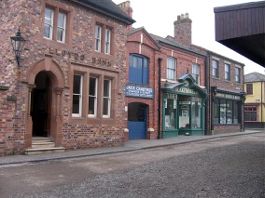 The
Blist Hill Victorian Town museum is a fantastic place for the whole family to enjoy,
there is I am sure, something that will interest any imagination. The museum is
a recreation of a working Victorian town, based around some existing Victorian industrial
buildings which include the brick & tile works; tinsmiths, iron foundry and
blast furnaces. Linking these industrial relics, a village has been created, which
now includes buildings such as the bank, butchers, bakers, candle makers, printers,
locksmiths, cobblers, slaughter house, blacksmith to name but a few! The site spans
a length of over 1 mile and provides many hours of entertainment.
The
Blist Hill Victorian Town museum is a fantastic place for the whole family to enjoy,
there is I am sure, something that will interest any imagination. The museum is
a recreation of a working Victorian town, based around some existing Victorian industrial
buildings which include the brick & tile works; tinsmiths, iron foundry and
blast furnaces. Linking these industrial relics, a village has been created, which
now includes buildings such as the bank, butchers, bakers, candle makers, printers,
locksmiths, cobblers, slaughter house, blacksmith to name but a few! The site spans
a length of over 1 mile and provides many hours of entertainment.
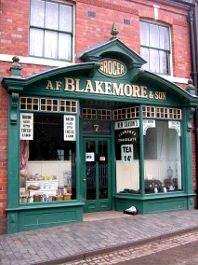 As
well as the existing Victorian and recreated Victorian buildings the museum is brought
to life by craftsmen and actors taking the parts of the townsfolk thus breathing
life into the town. For example in the bakers, you can watch them produce the bread
by hand and then even buy the warm loaves fresh from the ovens. In the candle makers,
they make and demonstrate how candles are made by hand using the drip wax method.
The candles produced here in the nineteenth century were very special as they had
a machine that would twist the wick, so giving a double wick through the candle
which then gave off more light when burnt.
As
well as the existing Victorian and recreated Victorian buildings the museum is brought
to life by craftsmen and actors taking the parts of the townsfolk thus breathing
life into the town. For example in the bakers, you can watch them produce the bread
by hand and then even buy the warm loaves fresh from the ovens. In the candle makers,
they make and demonstrate how candles are made by hand using the drip wax method.
The candles produced here in the nineteenth century were very special as they had
a machine that would twist the wick, so giving a double wick through the candle
which then gave off more light when burnt.
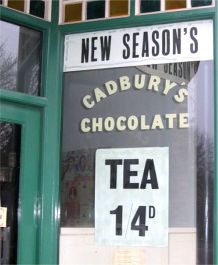 Entering
the town you walk through what is the High Street with its shops and bank. You may
enter any of these premises and can learn all about the profession at that period
from the costumed staff. My first port of call was to the general grocers shop.
Attracting me to this shop was an advert for tea at 14d (6p). Inside the shop was
an array of general grocery items and hardware. On the wooden counter I spied packets
of tea for sale, the paper packets labelled 'A.F. Blakenmore - finest blend clipper
tea' written in black ink using a dip pen. This had to be my first souvenir to take
home to enjoy-so I bought a bag. Behind the well-stocked counter and on the top
of the shelves behind were a row of red tin tea canisters, from which tea could
be bought loose to the Victorian customers. Commodities such as tea would be bought
in bulk by the grocer, who would mix their own blends and sell in small quantities.
Entering
the town you walk through what is the High Street with its shops and bank. You may
enter any of these premises and can learn all about the profession at that period
from the costumed staff. My first port of call was to the general grocers shop.
Attracting me to this shop was an advert for tea at 14d (6p). Inside the shop was
an array of general grocery items and hardware. On the wooden counter I spied packets
of tea for sale, the paper packets labelled 'A.F. Blakenmore - finest blend clipper
tea' written in black ink using a dip pen. This had to be my first souvenir to take
home to enjoy-so I bought a bag. Behind the well-stocked counter and on the top
of the shelves behind were a row of red tin tea canisters, from which tea could
be bought loose to the Victorian customers. Commodities such as tea would be bought
in bulk by the grocer, who would mix their own blends and sell in small quantities.
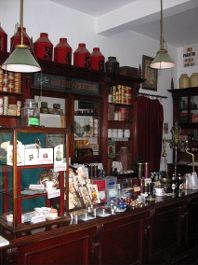
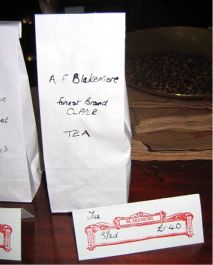
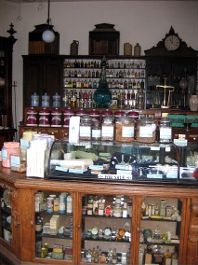 Leaving
the Grocers, I continued down the street calling into the chemists. This very old
fashioned looking shop had a wealth of cures for common ailments as well as the
more luxury items such as soaps, bath salts and perfumes. At one end of the shop
was a dental surgery! This very basic-looking dentist, would I am sure brought some
relief to those suffering from tooth ache - even if to my eyes the tools looked
primitive. There were anaesthetics, but only for those who could afford it!
At the other end of the chemists they sold spectacles and had a basic letter chart
to help in testing of eyes.
Leaving
the Grocers, I continued down the street calling into the chemists. This very old
fashioned looking shop had a wealth of cures for common ailments as well as the
more luxury items such as soaps, bath salts and perfumes. At one end of the shop
was a dental surgery! This very basic-looking dentist, would I am sure brought some
relief to those suffering from tooth ache - even if to my eyes the tools looked
primitive. There were anaesthetics, but only for those who could afford it!
At the other end of the chemists they sold spectacles and had a basic letter chart
to help in testing of eyes.
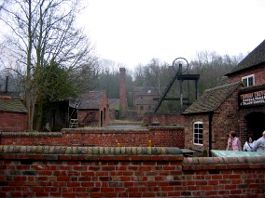 Behind
the Victorian High Street are the remaining buildings of the original brickworks.
These were in use in the eighteenth century when the area took off as an industrial
site. By the late eighteenth century coal mining was also an established industry
here. The brickworks is sited on high ground compared to the River Severn, which
flows through the Gorge below. In 1786 a Quaker Ironmaster tried to connect the
Blists Hill mines with the River Severn by tunnelling through the hill from Coalport.
However, he hit a natural seam of bitumen, which he decided to mine and profit from
instead. The Tar tunnel, as it is known, still remains and is open to the public
as one of the museums in the Ironbridge Gorge. There was a canal, the Shropshire
Canal, which navigated through the Blists Hill industries, but did not connect with
the river because of the great difference in height between the canal and the river.
An ingenious engineering design for an Inclined Plane railway was devised and built
in 1793, which successfully linked the Shropshire canal and the River Severn completing
the transport link between them for the transportation of materials. The system
used tub boats which were floated onto wheeled cradles. These cradles were then
hoisted up and down the Inclined Plane, where the tub boats were floated off the
wheeled cradle.
Behind
the Victorian High Street are the remaining buildings of the original brickworks.
These were in use in the eighteenth century when the area took off as an industrial
site. By the late eighteenth century coal mining was also an established industry
here. The brickworks is sited on high ground compared to the River Severn, which
flows through the Gorge below. In 1786 a Quaker Ironmaster tried to connect the
Blists Hill mines with the River Severn by tunnelling through the hill from Coalport.
However, he hit a natural seam of bitumen, which he decided to mine and profit from
instead. The Tar tunnel, as it is known, still remains and is open to the public
as one of the museums in the Ironbridge Gorge. There was a canal, the Shropshire
Canal, which navigated through the Blists Hill industries, but did not connect with
the river because of the great difference in height between the canal and the river.
An ingenious engineering design for an Inclined Plane railway was devised and built
in 1793, which successfully linked the Shropshire canal and the River Severn completing
the transport link between them for the transportation of materials. The system
used tub boats which were floated onto wheeled cradles. These cradles were then
hoisted up and down the Inclined Plane, where the tub boats were floated off the
wheeled cradle.
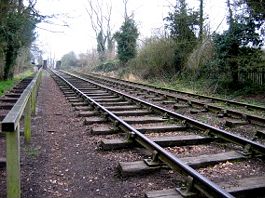
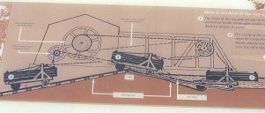
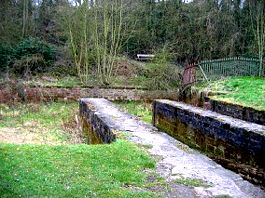
Returning to the Victorian High Street, I passed through the town's pub 'The New Inn', with its simply furnished bars; The Printers, where they printed all kinds of personal stationary, notices and even flags for bunting; G. Phillips - the Draper & Milliners and the Old School Rooms. There was a lot to see in all these and other buildings and shops. At the school the school mistress could be seen ringing her bell to call the children to school and inside the children sat at desks with hard seats, a small slate and chalk.
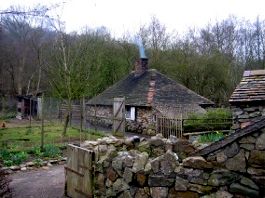 Further
along, I found a really charming Squatters Cottage. Set in its own little farm yard,
with chickens,
Further
along, I found a really charming Squatters Cottage. Set in its own little farm yard,
with chickens,
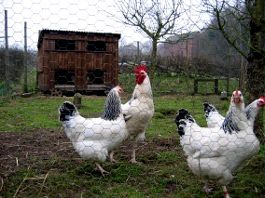 geese
and a pig and a water hand pump down someway from the house. The house was built
sometime between 1825-41 on waste ground around three miles from where it is now
sited. Built from rubble stone, it has small windows and a wooden roof, made from
ash and birch. A central chimney is smoking from the cooking range within the main
room of the house. Hanging on the outside wall of the house is an old tin bath,
the only way to keep clean.
geese
and a pig and a water hand pump down someway from the house. The house was built
sometime between 1825-41 on waste ground around three miles from where it is now
sited. Built from rubble stone, it has small windows and a wooden roof, made from
ash and birch. A central chimney is smoking from the cooking range within the main
room of the house. Hanging on the outside wall of the house is an old tin bath,
the only way to keep clean.
Inside were two ladies in costume sat chatting in front of the warm range. On the range there was a kettle boiling and hissing away ready for them to make the all important pot of tea. To the side of them, a table on which are some vegetables to be prepared for the dinner. There are only two rooms to the house, the main room and a bedroom. the toilet is an outside building separate to the house.
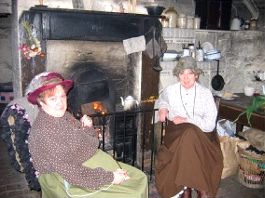
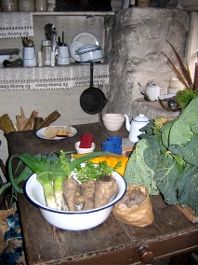
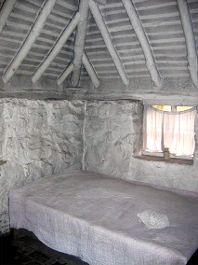
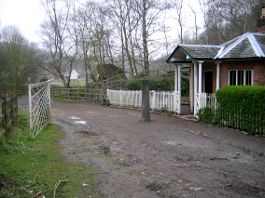 One
more place I had time to visit was the Shelton Tollhouse and Telford Road. Built
around 1829-30, this pretty toll house originally stood at Shelton, West of Shrewsbury
on the road built by Thomas Telford. Telford constructed the London to Holyhead
Road sometime after 1815 and he was responsible for standardising mileposts, tollhouses,
footpaths as well as the actual method of road construction.
One
more place I had time to visit was the Shelton Tollhouse and Telford Road. Built
around 1829-30, this pretty toll house originally stood at Shelton, West of Shrewsbury
on the road built by Thomas Telford. Telford constructed the London to Holyhead
Road sometime after 1815 and he was responsible for standardising mileposts, tollhouses,
footpaths as well as the actual method of road construction.
The Toll House was designed and built to a high and comfortable standard to attract a responsible person to become the toll collector. It was he who collected the toll off passing carts etc. Only people on foot, could pass along the toll section without having to pay. The toll keeper would not have been a popular person with those wishing to travel along the road in their horse drawn transport!
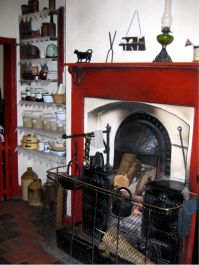
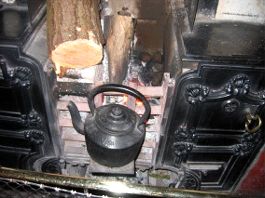
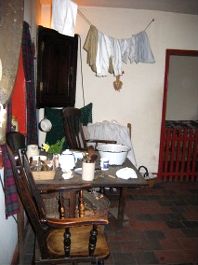
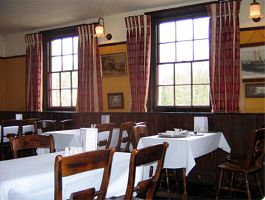 After
an enjoyable time within the Blists Town museum, before leaving I treated myself
to tea in the Victorian Tea Room. Here, I enjoyed a pot of tea with a very moist
slice of Chocolate and Orange cake. The cakes on offer were all home-made and of
a very good standard. As one might expect a Victoria Sandwich sponge cake was amongst
the choice of cakes. It is nice that the tea room was in keeping with the rest of
the feel of the museum. It had an upright piano in one corner, but alas nobody to
play it.
After
an enjoyable time within the Blists Town museum, before leaving I treated myself
to tea in the Victorian Tea Room. Here, I enjoyed a pot of tea with a very moist
slice of Chocolate and Orange cake. The cakes on offer were all home-made and of
a very good standard. As one might expect a Victoria Sandwich sponge cake was amongst
the choice of cakes. It is nice that the tea room was in keeping with the rest of
the feel of the museum. It had an upright piano in one corner, but alas nobody to
play it.
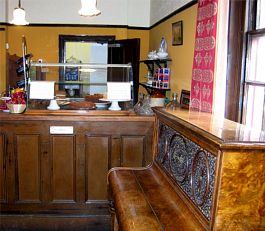
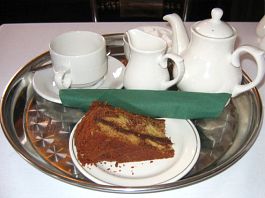
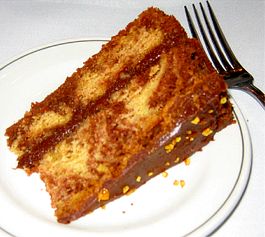
Feeling replete from my tea and cake, I walked from the Blist Museum, down into the Gorge to visit the Coalport China Museum -I will be reporting on this in another Tea Clipper newsletter, where you can share with me all the wonderful porcelain, including many tea wares that are on display. Also, when I was there, there was a special exhibition of Caughley porcelain.
Blists Hill-Victorian Town
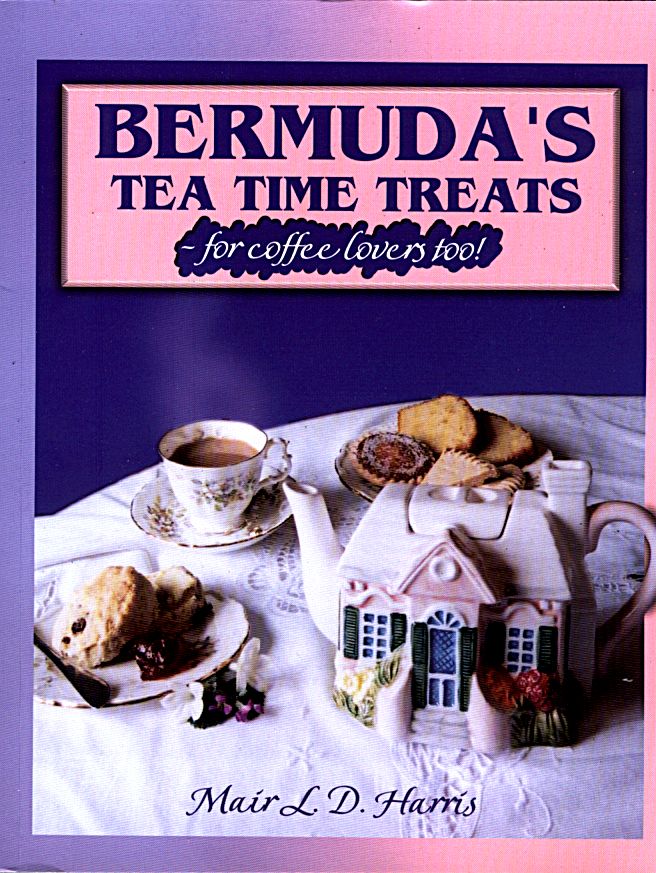 I
recently had the pleasure of being sent a copy of a book by its author Mair L. D.
Harris, called 'Bermuda's Tea Time Treats - for Coffee lovers too! I found this
a really charming book written by Mair, who has a strong life long passion for afternoon
tea. Having spent much of her adult life in the beautiful Island of Bermuda,
she has some fantastic recollections of afternoon teas given by ladies of the island,
using their traditional tea time treats.
I
recently had the pleasure of being sent a copy of a book by its author Mair L. D.
Harris, called 'Bermuda's Tea Time Treats - for Coffee lovers too! I found this
a really charming book written by Mair, who has a strong life long passion for afternoon
tea. Having spent much of her adult life in the beautiful Island of Bermuda,
she has some fantastic recollections of afternoon teas given by ladies of the island,
using their traditional tea time treats.
The book begins with some very interesting history of tea and tea growing around the world and gives some interesting facts. It then moves on to give some mouth watering recipes from the Island of Bermuda, given by ladies of Bermuda. These include such things as Johnny bread, Hyacinth's Tea Cake, Double Lemon Shortbread and Tomato Jam. Not only are recipes from Bermuda featured, but favourite tea time recipes treats from eleven different countries around the world, including Britain. There are also treats for Coffee lovers too.
Finally, there are sections on tea equipage, tea trivia as well as a thoughtful weights and measurers conversion - essential information for a wide audience to try the recipes.
I found the book a fascinating read and a book that I would recommend to tea lovers around the world. I cannot wait to try out some of the recipes for myself.
Mair is also currently working on a further book 'Bath's Tea Time Treats' - for Coffee lovers too! As Bath in England is one of my favourite cities, I eagerly await the publication of this book.
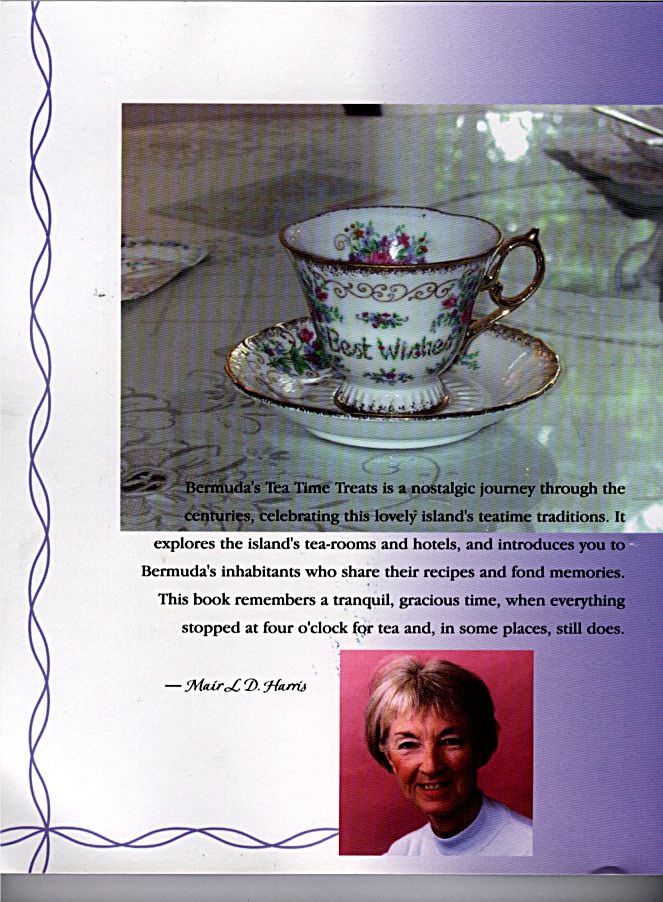
To review past newsletters, just follow this link:
Past newsletters.
To subscribe to this free newsletter -
Click here